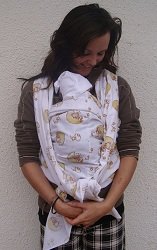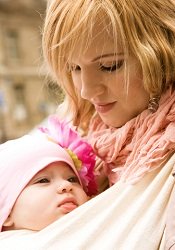Babywearing
Amazing benefits of baby carrying that every parent should read.

Babywearing is a term used to describe the practice of an adult wearing or carrying a baby or toddler in a baby sling or other form of baby carrier.
For centuries mothers have traditionally carried their babies and now modern research has shown that it offers many benefits to both babies and their parents.
Infant carrying, or wearing a baby using a soft carrier or sling, meets a baby's need for physical contact, comfort, security, stimulation and movement - all of which help to promote neurological development.
Baby carriers and slings help increase the number of hours of day an infant is held, which increases the benefits listed below.
Benefits of Babywearing
1. Increases oxytocin in the motherClose physical contact increases the production of the hormone oxytocin in the mother. This hormone promotes maternal bonding, breastfeeding and nurturing, which has been shown to reduce the incidence of post partum depression and psychosomatic illness in the mother.1
2. Decreases cryingBabies that are carried know that their mother (or caregiver) will meet all their needs and are therefore more secure and content. They cry less than babies that are not carried. "The increased carrying reduces crying behavior but promotes proximity so that crying is less necessary."
In a much-quoted study, researchers found that at the time of peak crying (6 weeks of age), infants who received supplemental carrying cried and fussed 43% less overall, and 51% less during the evening hours (4pm to midnight). Similar but smaller decreases [in crying] occurred at 4, 8, and 12 weeks of age. 2
 3. Develops security
3. Develops security
Wearing a baby helps develop a sense of trust and security. Children that are secure tend to become independent at an early age.
4. Increases mother-baby attachmentBabywearing increases attachment between the baby and mother (or caregiver) significantly.3
5. Affects brain developmentResearch has shown that a lack of physical affection changes how the brain develops, and can lead to anxiety and poor relationships later in life. In contrast, lots of love and physical affection from parents and carers help to develop brain 'pathways' involved in coping with stress and forming good social bonds.4
6. Reduces risk of flat head syndromeBabywearing decreases the risk of positional plagiocephaly (flat head syndrome) which is caused by extended time in an infant car seat and by sleeping on the back. Sleeping on the back is recommended to decrease the risk of Sudden Infant Death Syndrome (cot death) but is believed to have caused an increase in plagiocephaly. Babywearing positions do not require babies to lie in a supine position and therefore reduce the incidence of this cranial distortion occurring.5
7. Increases sensory stimulationBaby-wearing provides movement and sensory stimulation for the development of the baby's vestibular system and sensory neuropsychological processes. "There are good reasons why infants and children seek to be carried on the body of their mothers and fathers and love to be rocked to sleep." Rythmic movement has a soothing effect on infants.
Research has shown that babies deprived of this kind of parental love develop pathological social-emotional conditions.6 Stimulation of the vestibular system also helps babies to become more organized more quickly.
8. Enables mother to be hands-freeBabywearing allows the mother to have two free hands to accomplish other tasks, while still meeting the baby's need to be held and comforted.
9. ConvenientWearing a baby is safer and more convenient than many other baby carriers, such as car-seats, prams, swings or rockers. It is also a more comfortable way to transport a baby, rather than carrying a heavy car seat. When soft carriers are used, the baby's weight is distributed more evenly across the upper body of the adult.
10. Improves social and linguistic skillsInfant wearing enables the baby to see the world from a different perspective than from a knee-high stroller. They can experience social interactions at the same level as adults when carried. This facilitates the development of social skills such language, recognizing facial expressions and body language.
11. Benefits premature babiesBabywearing, along with kangaroo mother care offers many benefits to premature and low birth weight babies, including improved feeding and faster weight gain.
More Pages Related to Babywearing
Instructions for Wearing Your Baby Sling
Back to Newborn Baby Care
References
- Lonstein, Joseph S., Regulation of anxiety during the postpartum period, Frontiers in Neuroendocrinology, Volume 28, Issues 2-3, August-September 2007
- Urs A. Hunziker, MD, and Ronald G. Barr, MDCM, FRCP(C), Increased Carrying Reduces Infant Crying: A Randomized Controlled Trial, From the Department of Pediatrics, The McGill University-Montreal Children's Hospital Research Institute, Montreal, Quebec, Canada, http://www.portareipiccoli.it/trial_hunziker.htm, retrieved 22 September 2010.
- Anisfeld, E., Casper, V., Nozyce, M., & Cunningham, N. (Oct., 1990). Does Infant Carrying Promote Attachment? An Experimental Study of the Effects of Increased Physical Contact on the Development of Attachment. Child Development, Vol. 61, No. 5, 1617-1627.
- Alison B. Wismer Fries, Toni E. Ziegler, Joseph R. Kurian, Steve Jacoris, Seth D. Pollak, Early experience in humans is associated with changes in neuropeptides critical for regulating social behavior, PNAS, November 22, 2005 vol. 102 no. 47 17237-17240
- Littlefield, Timothy R. Car Seats, Infant Carriers, and Swings: Their Role in Deformational Plagiocephaly, Journal of Prosthetics & Orthotics 15, no. 3 (2003): 102-106.
- Lothar Wolff (Executive Producer), Rock A Bye Baby, A Time Life Documentary (1970), http://www.violence.de/tv/rockabye.html, retrieved 22 September 2010
Disclaimer: All information is provided for informational purposes only, although every effort is made to provide accurate and current information.
The site content is not intended to be or to substitute for medical advice, diagnosis, or treatment.
Always seek the advice of a suitably qualified health care professional regarding your individual medical needs.
Pregnancy and Giving Birth.com is not responsible nor liable for any advice, course of treatment, diagnosis, services or products obtained via this website.
Return to Top of Babywearing
All Rights Reserved.

